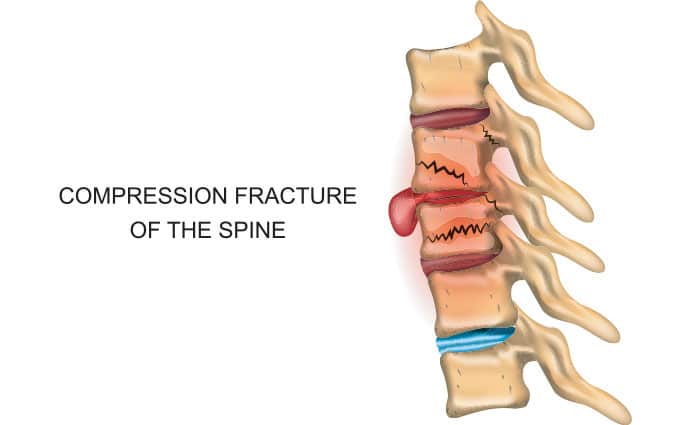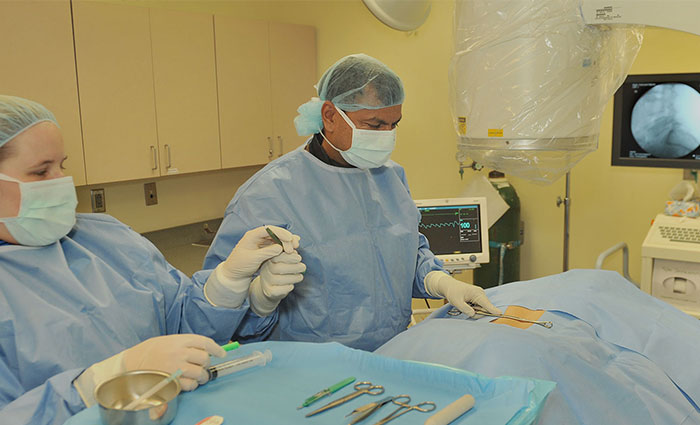If you’ve recently suffered from a spinal compression fracture, your orthopaedist may have suggested kyphoplasty as a possible treatment. But what exactly is kyphoplasty, and how can it help alleviate back pain? In this article, our orthopaedic spine specialists provide helpful information about the kyphoplasty procedure to help you better understand it and make informed decisions about your spine health.
What is a compression fracture?
The aging process and osteoporosis can cause tiny cracks in the vertebrae that form your spine. When multiple small hairline fractures occur, they can cause the vertebra to collapse, resulting in a spinal compression fracture. A compression fracture is essentially a break in one of your vertebrae and can be incredibly painful, causing bone fragments to rub against each other. This type of fracture primarily occurs in the thoracic region of the spine (middle of the back) but may also occur in the lumbar region (low back), as well.
Most compression fractures occur in the front of the vertebra. When they add up, only the front part of the vertebra will collapse. The back side of the vertebra is made up of stronger bone, so it stays intact. This wedge-shaped vertebra can lead to a stooped posture known as dowager’s hump. Doctors refer to this as “kyphosis.”
Older adults with osteoporosis or individuals with cancer that has spread to their bones are most at risk for compression fractures.
What is kyphoplasty?
Kyphoplasty is a minimally invasive surgery used since 1998 to treat spinal compression fractures. The goals of kyphoplasty are as follows:
- Stabilize the vertebra
- Restore the bone to its normal height
- Reduce pain from the fracture
Our spine surgeon will start by making a small, half-inch incision over the fractured area. Using the guidance of X-ray, the surgeon will insert a thin tube through the connective tissue into the side of the vertebra. A balloon is then placed through the tube and into the vertebra. The balloon is inflated inside the vertebra to create an open space and restore height to the collapsed bone. The balloon is then deflated and removed, leaving the new vertebra cavity behind. Depending on the severity of the fracture, more than one balloon may be used.
Once there is open space in the bone, a type of bone cement is injected through a needle to fill the entire cavity. The cement hardens quickly, stabilizing the fracture with an internal cast.
What should I expect if I’m having kyphoplasty surgery?
Kyphoplasty is generally performed in-office at Cary Orthopaedics. The procedure begins with the patient lying face down on the operating table. Before the procedure, patients are anesthetized, numbing the affected area. Our physician will guide a needle through the skin of your back into the fractured vertebra.
Once the procedure has been completed and the fracture has been stabilized, the needle is removed, and the opening in your skin is closed. You may need to lie on the table for a few minutes, allowing the cement to harden. Stitches and bandages are not necessary. The entire procedure usually takes less than one hour if only one vertebra is being treated.
Recovery time is minimal, and most patients can walk out the door the same day. Full recovery may take up to 48 hours.
How can I find out if I’m a candidate for kyphoplasty?
Cary Orthopaedics offers many options to relieve back pain, including the most advanced minimally invasive surgeries, including kyphoplasty. If an evaluation with our spine physician finds that kyphoplasty is an appropriate treatment for your condition, patients can take advantage of our convenient, in-office procedure room where the procedure can be performed safely and effectively.
As the region’s only comprehensive spine specialty practice, Cary Orthopaedic Spine Center offers full-service care to patients who suffer from neck and back pain or spinal disorders. Schedule an appointment HERE.








